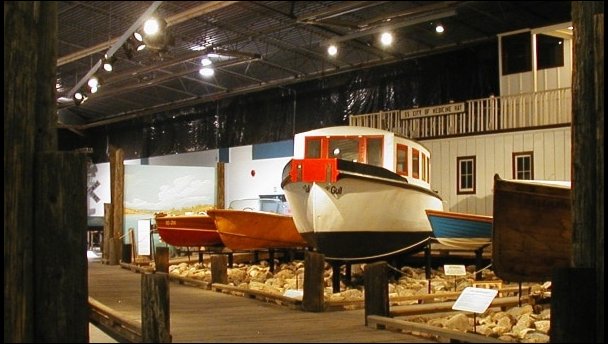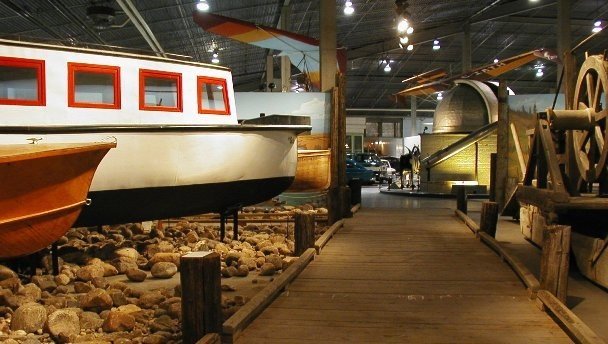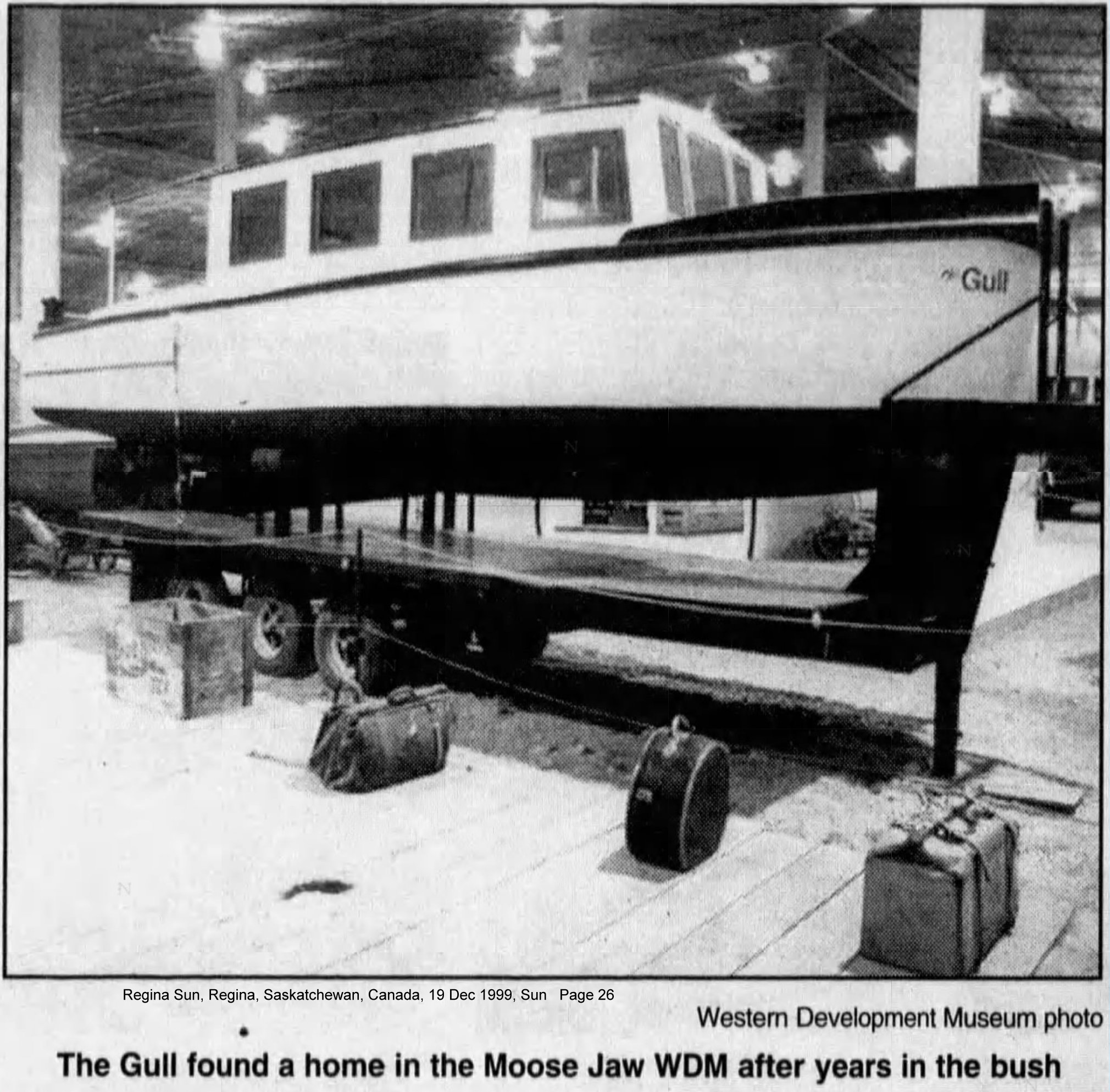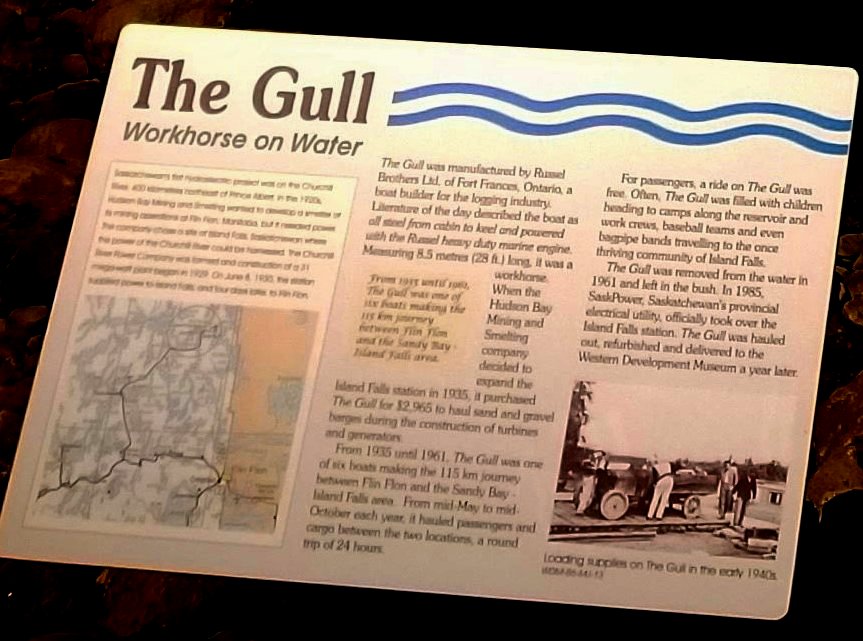Russel Brothers Limited OWEN SOUND, ONTARIO Steelcraft Boat Builders
| Gull
Built at Fort Frances, Ontario, in 1935. Purchased in 1937 by Hudson Bay Mining and Smelting. When the mining company decided to expand the Island Falls station in the 1930's, it purchased The Gull to haul barges of gravel. Hauled materials to Island Falls, Saskatchewan's first hydroelectric project, 400 km northeast of Prince Albert. From 1937 until 1961, The Gull also provided transportation for the people of Sandy Bay. It was removed from the water in 1961. Restord by Armand Aden, who donated The Gull to the Western Development Museum in 1986, where it is displayed in the water transportation gallery at the WDM in Moose Jaw. |
 |
Western Development Museum Moose Jaw WATERCRAFT GALLERY: Check out a steamboat fashioned after the ill-fated S. S. City of Medicine Hat which sank after hitting a bridge in Saskatoon in 1908. Other watercrafts featured include the Okeehumkee, a boat built in Regina, SK in 1912, and the Gull, purchased in 1935 by Hudson Bay Mining and Smelting. This gallery also houses a canoe built in 1933, a reconstructed ferry, a rowboat, and a motorboat. https://wdm.ca/exhibits/watercraft/ |
 |
Moose Jaw: This Western Development Museum highlights the modes of transportation that changed the face of the prairies. Automobiles, rail, vintage aircraft � this museum has it all! The aviation exhibits include a dedicated Snowbirds aerobatic team display. Gift shop, picnic tables and ample free parking. https://www.tourismsaskatchewan.com/listings/648/western-development-museum---moose-jaw/ |
 | |
Regina Sun
Regina, Saskatchewan
Sun, 19 Dec 1999, Page 26
By NOELLE GROSSE of the Western Development Museum.
Though Saskatchewan's geographic centre is well above Prince Albert on the map, relatively few artifacts from northern industry have emerged from the forest. The dense bush almost claimed The Gull, a Steelcraft boat that hauled materials to Island Falls, Saskatchewan's first hydroelectric project, 400 km northeast of Prince Albert. From 1937 until 1961, The Gull also provided transportation for the people of Sandy Bay. It was removed from the water in 1961 and left in the bush for two decades.
Lyle (Slim) Woods remembers when The Gull hauled up to 30 people across Mari Lake, near the Manitoba border. Woods operated the boat for the Churchill River Power Company from 1943 to 1952. I made freight trips and passenger trips, recalls the 87-year-old, who still spends his summers in a cabin near Sandy Bay. From mid-May to mid-October, Woods hauled passengers between Flin Flon and Island Falls, a round trip of 24 hours. The Gull was one of six boats he operated because the 115 km journey included six lakes separated by fingers of land, with no towns along the way. Between the lakes, the passengers had to portage.
"All the passengers would have to walk, says Woods. Some of them were good, but others got really cranky." In the summer, The Gull was filled with children heading to camps along the reservoir. Woods says he hauled work crews, baseball teams and even bagpipe bands to the once thriving community of Island Falls. A ride in The Gull was a little noisy, but it was free. "Just sign the release form and away you went," Woods says. "There was no such thing as life jackets in those days."
Though The Gull ferried many passengers, it was no luxury liner. The 8.5 metre boat has been described as a workhorse, and that is why it was purchased by Hudson Bay Mining and Smelting in 1937. In the 1920's, Hudson Bay Mining and Smelting wanted to develop a smelter at Flin Flon, but it needed power. The company chose a site at Island Falls, where the power of the Churchill River could be harnessed. The Churchill River Power Company was formed and construction of a 31 mega-watt plant began in 1929.
The Island Falls station was a remarkable achievement, considering that 23,000 tons of material was hauled over frozen lakes. Twelve cleat-track Linn tractors hauled loads of steel and cement over the ice. On June 8, 1930, the station supplied power to Island Falls, and four days later, to Flin Flon. Under an agreement with the Saskatchewan government, one-sixth of the power generated by the plant was used in the province. When the mining company decided to expand the Island Falls station in the 1930's, it purchased The Gull to haul barges of gravel.
The boat was manufactured by Russel Brothers Ltd. of Fort Frances, Ont., which made boats for the logging industry. By coincidence, Slim Woods spent much of his childhood in Fort Frances. He recalls walking by the Russel factory and seeing large boats being built in the yard. He moved to northern Saskatchewan in 1930, and several years later, The Gull made a similar journey.
The Gull might still be sitting in the northern bush had it not been salvaged by Armand Aden, who first came across the boat in the summer of 1963. At the time I first saw it, it was sitting in the bush pretty well grown over, Aden says from his home in Denare Beach, Sask. SaskPower officially took over the Island Falls station in 1985.
That year, Aden bought The Gull and began restoring it. Parts for the boat were scattered across the region. "The steering wheel was in Flin Flon," he says. "Someone had installed it on their front gate." Aden arranged for the boat to be towed 600 km to the construction site of a power station at Nipawin in 1985. The construction company lent equipment for sandblasting and painting, and mechanics volunteered to build replacement parts.
"I was pretty proud that we actually got the thing running," Aden says. He estimates that he spent' 500 hours restoring the boat. He donated The Gull to the Western Development Museum in 1986, where it is displayed in the water transportation gallery at the WDM in Moose Jaw.
Slim Woods says he plans to visit The Gull some day. He admits that it has been a while since his last visit. "The last time I saw Moose Jaw was in 1929, he says with a laugh." The Gull is waiting, and it looks better than ever. (For information about the Western Development Museum collection, call the WDM Curatorial Centre at (306) 934-1400.
 |
Many thanks to Julie Jackson, Collections Manager, WDM Corporate Office for sending over these high resolution images.
 |
The Gull was manufactured by Russel Brothers Ltd. of Fort Frances, Ontario, a boat builder for the logging industry. Literature of the day described the boat as "all steel from cabin to keel and powered with the Russel heavy duty marine engine." Measuring 8.5 meters (28 ft.) long, it was a workhorse.
When the Hudson Bay Mining and Smelting company decided to expand the Island Falls station in 1935, it purchased the Gull for $2,965 to haul sand and gravel barges during construction of turbines and generators.
From 1935 until 1961, The Gull was one of six boats making the 115 km journey between Flin Flon and the Sandy Bay - Island Falls area. From mid-May to mid-October each year, it hauled passengers and cargo between the two locations, a round trip of 24 hours.
For passengers, a ride on the Gull was free. Often, The Gull was filled with children heading to camps along the reservoir and work crews, baseball teams and even bagpipe bands travelling to the once thriving community of Island Falls.
The Gull was removed from service in 1961 and left in the bush. In 1985, SaskPower, Saskatchewan's provincial electrical utility, officially took over the Island Falls station. The Gull was hauled out, refurbished and delivered to the Western Development Museum a year later.
|
For more Russel exhibits visit Owen Sound Marine & Rail Museum 1165 1st Ave West, Owen Sound, ON N4K 4K8
(519) 371-3333  http://marinerail.com http://marinerail.com |